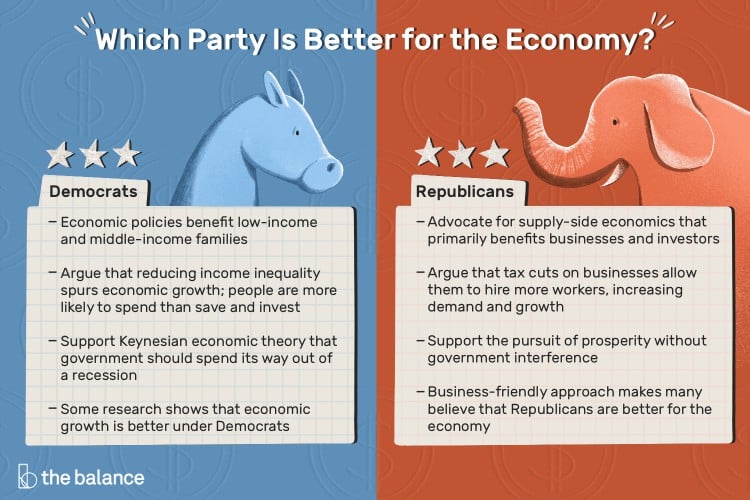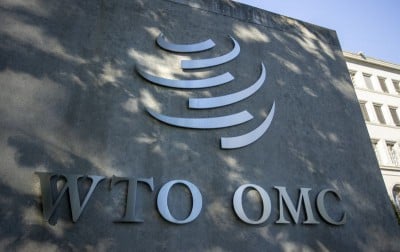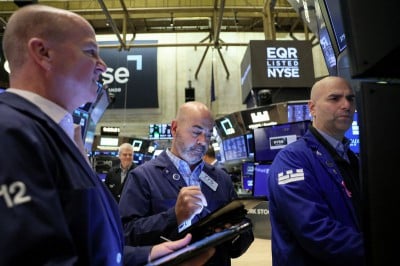
The Balance / Julie Bang
Democrats and Republicans have widely different views on the economy. But once in power, candidates’ actions don’t always coincide with their party’s views. That makes it difficult to determine which party is better for the economy.
Key Takeaways
- Many factors influence how much impact Republican or Democratic presidents have on economic performance.
- These factors include recessions, wars, and prior presidents’ policies.
- Some research shows that economic growth is better under Democrats.
The Philosophy Behind Democratic Economic Policy
Generally, Democrats gear their economic policies to benefit low- and middle-income families. They argue that reducing income inequality is the best way to foster economic growth. Low-income families are more likely to spend discretionary money on necessities instead of saving or investing it. That directly increases demand and spurs economic growth. Democrats also traditionally support a Keynesian economic theory, which says that the government should spend its way out of a recession.
President Franklin D. Roosevelt first outlined the Economic Bill of Rights in his 1944 State of the Union address. It included taxes on war profiteering and price controls on food costs. President Harry Truman’s 1949 Fair Deal proposed an increase in the minimum wage, civil rights legislation, and national health care. President Barack Obama expanded Medicaid with the 2010 Affordable Care Act.
The Philosophy Behind Republican Economic Policy
Republicans advocate the right to pursue prosperity without government interference. They argue this is achieved by self-discipline, enterprise, saving, and investing.
Note
Republicans’ business-friendly approach leads most people to believe that they are better for the economy. A closer look reveals that Democrats are, in many respects, actually better.
The Party That’s Actually Best for the Economy
Many analyses look at which party is best for the economy. A study from the National Bureau of Economic Research found that Democratic presidents since World War II have performed much better than Republicans. On average, Democratic presidents grew the economy by 4.4% each year versus 2.5% for Republicans.
A study by Princeton University economists Alan Blinder and Mark Watson found that the economy performs better when the president is a Democrat. They report that “by many measures, the performance gap is startlingly large.” Between Truman and Obama, growth was 1.8% higher under Democrats than Republicans.
A Hudson Institute study found that the six years with the best growth were evenly split between Republican and Democrat presidents.
Most of these evaluations measure growth during the president’s term in office. But no president has control over the growth added during his first year. The budget for that fiscal year was already set by the previous president, so it's helpful to compare the gross domestic product (GDP) at the end of the president’s last budget to the end of their predecessor’s last budget.
For Obama, that would be the fiscal year from October 1, 2009, to September 30, 2018. That’s FY 2010 through FY 2017. During that time, annual GDP increased from $15.6 trillion to $17.7 trillion, or 14%. That’s 1.7% per year.
The chart below ranks the presidents since 1929 on the average annual increase in GDP.
President | Final FY Budget | GDP (in Billions) | Added to GDP | % Increase | Annual Average |
|---|---|---|---|---|---|
| Roosevelt | 1945 | $2,352 | $1,524 | 184% | 15.3% |
| LBJ | 1969 | $4,792 | $1,089 | 29% | 5.9% |
| JFK | 1964 | $3,703 | $443 | 14% | 4.5% |
| Clinton | 2001 | $13,131 | $3,446 | 36% | 4.4% |
| Reagan | 1989 | $8,867 | $2,107 | 31% | 3.9% |
| Nixon | 1974 | $5,687 | $895 | 19% | 3.7% |
| Carter | 1981 | $6,759 | $810 | 14% | 3.4% |
| Eisenhower | 1961 | $3,260 | $685 | 27% | 3.3% |
| Trump | 2019 | $19,091 | $1,360 | 8% | 2.6% |
| GW Bush | 2009 | $15,605 | $2,474 | 19% | 2.4% |
| GHW Bush | 1993 | $9,685 | $818 | 9% | 2.3% |
| Obama | 2017 | $17,731 | $2,126 | 14% | 1.7% |
| Ford | 1977 | $5,949 | $262 | 5% | 1.5% |
| Truman | 1953 | $2,575 | $223 | 9% | 1.2% |
| Hoover | 1933 | $828 | $(282) | -25% | -8.5% |
The next table calculates the average annual growth for Democrats versus Republicans. Because of the Great Depression, Democrats grew the economy by 5.2% annually, while Republicans grew it by only 1.4%.
President | Democrats | Republicans |
|---|---|---|
Roosevelt | 15.3% | |
LBJ | 5.9% | |
JFK | 4.5% | |
Clinton | 4.4% | |
Reagan | 3.9% | |
Nixon | 3.7% | |
Carter | 3.4% | |
Eisenhower | 3.3% | |
| Trump | 2.6% | |
GW Bush | 2.4% | |
GHW Bush | 2.3% | |
Obama | 1.7% | |
Ford | 1.5% | |
Truman | 1.2% | |
Hoover | -8.5% | |
Total | 36.5% | 11.2% |
Annual Average | 5.2% | 1.4% |
Since the Depression was an outlier to this dataset, it makes sense to remove both FDR’s and Hoover’s results. Not counting the Depression, Democrats gained 3.6% on average, while Republicans gained 2.8%.
Note
A president would have better growth if he had no recession.
Another way to look at this debate is to consider what the presidents had to deal with during their terms. That’s one reason the Democrats did slightly better. Presidents Johnson, Carter, and Clinton didn’t have recessions. The only Republican president who could say that was Trump until 2020. All other presidents had to contend with some of the worst recessions in U.S. history.
Wars and postwar periods also disrupt the economy. They can sometimes spur growth if they occur during an economic contraction, but they also distract a president from the economy and can sap needed resources. Presidents Carter and Clinton were Democrats who avoided war, and Republican Presidents Ford, Reagan, and Trump can make the same claim.
The table below indicates economic turmoil during the presidents’ terms.
| President | Term | Event |
|---|---|---|
| Hoover | 1929–1933 | Market Crash, Depression |
| Roosevelt | 1933–1945 | Depression, WWII |
| Truman | 1945–1953 | WWII, Recession |
| Eisenhower | 1953–1961 | Korean War, Recession |
| JFK | 1961–1963 | Vietnam War, Recession |
| LBJ | 1963–1969 | Vietnam War |
| Nixon | 1969–1974 | Vietnam War, Stagflation, Recessions |
| Ford | 1974–1977 | Recession |
| Carter | 1977–1981 | Recession |
| Reagan | 1981–1989 | Recession, Black Monday |
| GHW Bush | 1989–1993 | Recession, Gulf War, S&L Crisis |
| Clinton | 1993–2001 | Growth, LTCM Crisis |
| GW Bush | 2001–2009 | 9/11, Recessions, Wars |
| Obama | 2009–2017 | Recession, Wars |
| Trump | 2017–2019 | No new wars or recessions until 2020 pandemic |
Policy Differences That Affect the Economy
Each party’s economic philosophy guides the policy choices its members make when they actually hold office. Here’s how those differences, in theory, have been made real in economic life.
Jobs
Republicans say that tax cuts are the best way to create jobs, while Democrats advocate government spending. The economic stimulus act, sponsored by Obama, used both. President Bill Clinton created 18.6 million jobs—more than any other president. The largest job creation, percentage-wise, was under President Roosevelt, who increased jobs by 21.5% during three terms. If you count only two terms, President Ronald Reagan was the largest, percentage-wise. He increased jobs by 16.5%.
Minimum Wage
Democrats argue that the minimum wage should allow a living wage. FDR created the minimum wage to protect workers during the Great Depression. During that time, it was $0.25 per hour, which translates to just under $5 in today’s economy.
Note
The Democratic Congress raised the minimum wage in 2007. It set a schedule to raise it to $7.25 an hour in 2009, where it is today.
Democrats, including President Joe Biden, support raising the minimum wage to $15 an hour.
Republicans argue that raising the minimum wage could force small businesses to lay off workers. A 2014 Congressional Budget Office report said that raising the minimum wage to $10.10 would take 900,000 families out of poverty. At the same time, it would cost 500,000 workers their jobs.
Taxes
Republicans favor regressive taxation that cuts taxes on businesses, investments, and high-income earners. Many initiatives taken by the Republican Party that did just that:
- In 2018, the Tax Cuts and Jobs Act cut the top income tax rate to 37% and lowered the corporate tax rate to 21%.
- The 2008 tax rebate, signed by G.W. Bush, sent a rebate to taxpayers, a third of whom saved it instead of spending it.
- In 2004, the Jobs and Growth Tax Relief Reconciliation Act cut taxes for businesses and reduced capital gains tax on investments.
- The 2001 Economic Growth and Tax Relief Reconciliation Act, signed by President G.W. Bush, cut the gift, estate, and alternative minimum tax.
Democrats believe in progressive taxation, demanding higher taxes on investments, big businesses, and high-income families.
- In 2010, Obamacare raised taxes on high incomes and investments.
- In 2009, Obama’s economic stimulus extended unemployment benefits.
- Clinton’s Omnibus Budget Reconciliation Act of 1993 raised the top income and corporate tax rates to 36%.
Climate Change
Democrats support conservation and have taken measures to stop global warming. In 2009, Democrats in Congress proposed a cap-and-trade policy with the American Clean Energy and Security Act. Republicans defeated it. In February 2019, congressional Democrats proposed the Green New Deal.
Note
Global warming affects every other economic issue. For example, the World Bank estimates that climate change could send 1.4 million immigrants north by 2050. Drought, shifting rain patterns, and extreme weather destroy crops and lead to food insecurity.
Republicans support the development of oil and gas production with federal government subsidies and tax cuts. Consumption of oil and gas contributes to global warming.
Republicans opposed the Kyoto agreement and repealed carbon emissions controls. Trump withdrew the United States from the Paris climate agreement.
Role of Government
Republicans don’t want government interference with a free-market economy. They advocate for deregulation. President Herbert Hoover supported laissez-faire economic policies. He believed the free market would self-correct during the Great Depression. Like many Republicans, he argued that economic assistance would make people stop working.
Note
Democrats favor more government intervention to protect Americans. Republicans want the government to play a minimal role in the marketplace.
Democrats advocate a strong federal government to support welfare and other social programs to help low-income families. During the depression, FDR rallied Americans to support massive government spending. In his first 100 days in office, he increased the debt by $4 billion to create 16 new agencies and laws. For example, the Works Progress Administration employed 8.5 million people to build bridges, roads, public buildings, parks, and airports. FDR was also responsible for the creation of Social Security. President Lyndon B. Johnson signed into law civil rights and urban renewal initiatives.
Democrats support regulations to protect consumers. For instance, President Woodrow Wilson pushed for the Clayton Antitrust Act to curb the power of trusts and monopolies in the U.S. market. FDR signed the Glass-Steagall Act, which banned banks from using deposits to buy risky investments.
The Debt
Republicans advocate fiscal responsibility, but they are almost as guilty as Democrats of increasing the debt. Obama increased the debt the most, dollar-wise, adding $8.6 trillion. President George W. Bush was second, adding $5.8 trillion.
Note
FDR increased the debt the most, percentage-wise, by 1,048%, while deploying efforts to fight the Great Depression and World War II.
President Wilson incurred the second-largest increase to the debt, percentage-wise, to pay for World War I.
On the other hand, Clinton created a $63 billion budget surplus with the Omnibus Budget Reconciliation Act of 1993. Every Republican president since Calvin Coolidge has added to the debt.
Trade
Democrats want trade agreements to protect American workers but traditionally have supported fair trade more than protectionism. That attitude has shifted in reaction to jobs outsourcing.
President Wilson signed the Underwood-Simmons Act to lower tariffs.
Note
Clinton signed the North American Free Trade Agreement, the world’s largest.
Reagan supported, and President George H.W. Bush negotiated NAFTA. Obama signed four trade agreements with four different nations—Colombia, Korea, Panama, and Peru—but these agreements were negotiated by the George W. Bush administration.
Frequently Asked Questions (FAQs)
What does the Libertarian party say about the economy?
Libertarians believe in a free market and that people should run their businesses in the way they want, without government interference. They believe that government stands in the way of innovation and that job creation and our economy would be better if the government were to stay out of it.
Are Democrats or Republicans better for the stock market?
Opinions differ, and there are many reasons why the market goes up and down. The president doesn't have as much influence over the economy as people think. It's more important to look at what happens when Democrats and Republicans are in Congress and which party is in the White House at the same time.
How many people in the U.S. are Democrats or Republicans?
As of April 2022, 28% of Americans identify as Democrats, 28% as Republicans, and 42% as independents.






